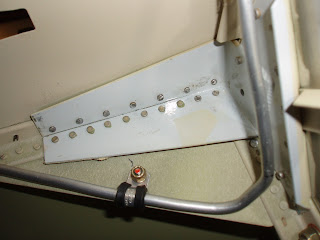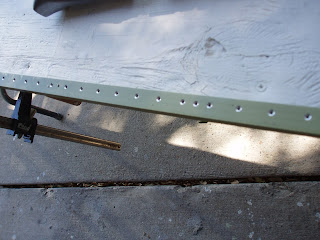Reference Tech Data:
a. Section 15 Final Inspection and Flight Test (Van's Aircraft)
b. Wing Incidence Drilling Simplified (Van's Aircraft)
Prior to rigging we set the incidence angle of both wings to be equal within 1-degree. It was only after installing the final wing attachment bolts that I appreciated Van's recommendation to (temporarily) install the wings using smaller diameter "hardware store" bolts - MUCH easier to install, perfect for this phase when making adjustments. Per the reference b procedure, we suspended plumb bobs (2 on each wing) from the leading edge to a strait line on the driveway, we were able to establish alignment/sweep between the L/H and R/H wings within 1/4-inch (1/2 is the high limit)

and an equal incidence angle within a 1/2-degree between the two wings, using a level and Vans's 4-0inch block aligned with the rivet line. As you can see, ailerons are set at neutral with a strait board with a strait line on it to attach to two tooling holes in the wing tip rib line and align with the aileron tip. All this, while 5/8 to 3/4 edge distance around the hole in the aft spar when we drill thru the existing hole in the wing aft spar, into the fuselage rear spar stub, AND keep the retracted flaps as close to the bottom of the fuselage as possible.

After all this, we were able to maintain 3/4-inch edge distance around the after spar attachment hole in the aft spar bars.

After all this, the L/H flap was nearly flush with the lower fuselage, R/H side not as good - about a 1/8-inch gap.
Rigging instructions are found on the referenced drawings and chapter 15 of Van's Assembly Manual . Segments in the FAQ section of Vans website were also helpful. Initial attachment of LH and RH ailerons revealed ailerons were not concurrently aligned with neutral position (strait line between tooling holes in tip rib and trailing edge, created using a strap board with 2-lines drawing along chordwise centerline). Review of drawing 38 revealed the F-665 (rod between control sticks)was too short (18 1/8 instead of 18 7/8). Made numerous adjustments, mostly to F-665 linkage between the two sticks, to ensure proper rodend engagement of both the pushrods in the wings, and
eventually both ailerons aligned with the neutral position at each wing tip. The fact that both long wing pushrods ended exactly the same length confirms that the sweep and incidence angle is the same on both wings.
The L/H flap fit nearly flush with the bottom of the fuselage skin, on the right side though we have about a 1/8-inch gap (i.e. lower flap skin 1/8-inch too low). According to Van's (ref. b), the gap is not a big deal, provided everything else is OK, and it is as noted above. The fix is to slightly bend the inboard edge of the flap until it is flush when retracted, I have also seen some rubber seals that do the job, we decided to go this route to prevent the flap motor from bottoming out metal to metal.
Rigging continued to be more involved than expected. After rigging the ailerons and flaps, the fiberglass wingtips were not in line with them (wing tips were not installed when setting incidence angle and sweep). This was fixed by splitting the trailing edge of wingtips and shifting upper and lower halves until alignment was established, then gluing and fastening them in-place with flush-flush solid rivets.
Now flaps, ailerons and wing tips are all in-line:
and the flap clears the side skin
The aileron stops are 3/4-inch diameter Delrin (chosen for impact strength, abrasion resistance, low water absorption, dimensional stability and machinability) disks installed on the inboard aileron pivot bolts. First an aluminum spacer was custom machined for the space remaining betyween the fitting lugs after installation of the rod ends and specified washers, then the Delrin disk was machined to be the same length as the aluminum spacer.
Here is an image of the L/H stop contacting the hinge bracket:
The R/H stop needed to be slightly larger than 3/4-inch (+1/16) in order to contact the bracket, likely because the hinge brackets are hand-made.
With the stops installed, actual aileron throw was measured to be 25/15 (reference up/down 25/15 to 32/17).
Next was installation of dual flap position sensors, one position sensor for the flap position panel display (lights) and one for VPX to be able to set the stops.



























































